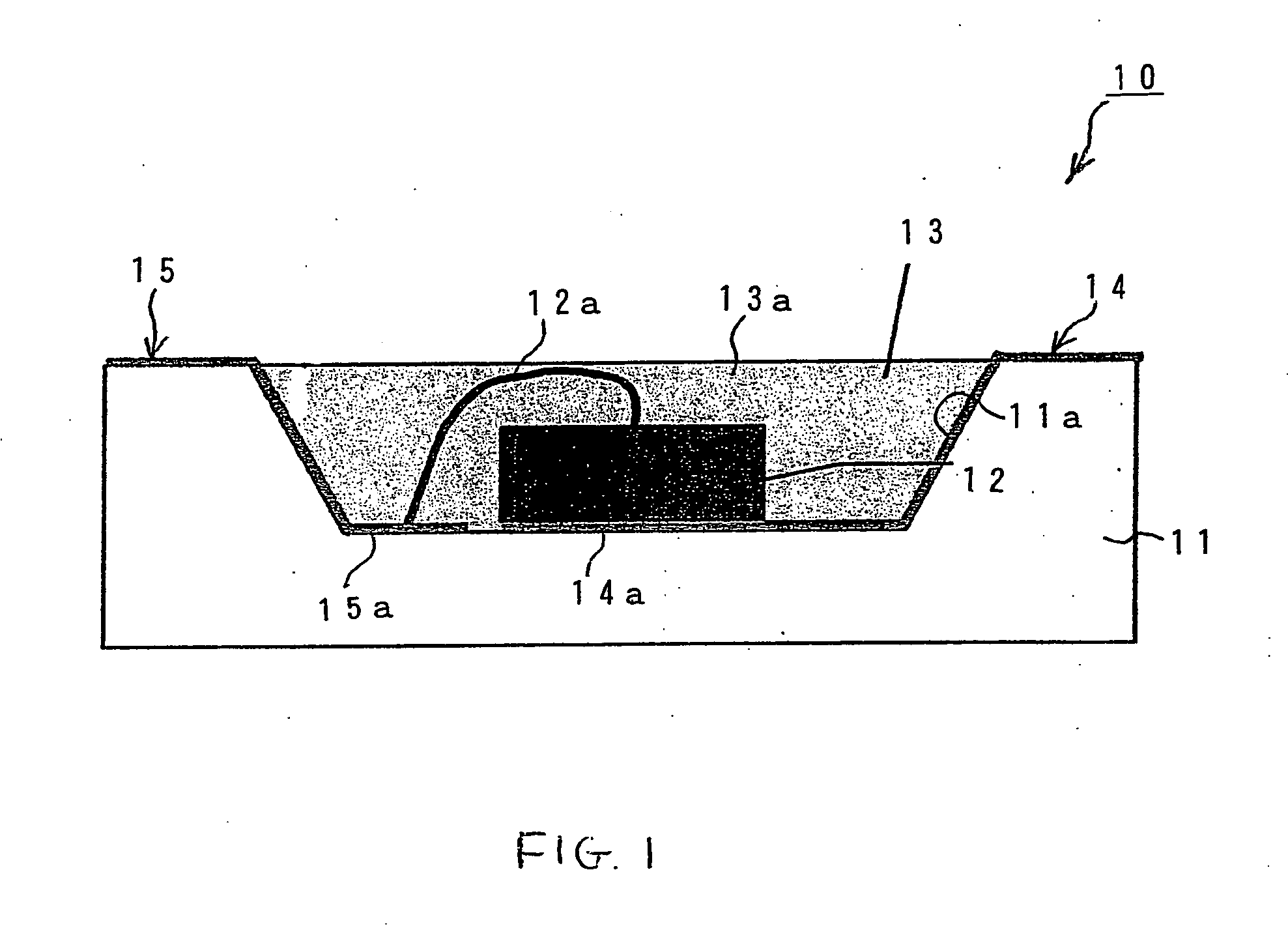Led and fabrication method of same
a technology of led and fabrication method, which is applied in the direction of semiconductor devices, electrical devices, transistors, etc., can solve the problems of increasing the number of joint parts, increasing the thermal resistance at the time of operation, and increasing the cost of parts and assembly, so as to achieve excellent suppression of the rise in temperature resulting from heat emission, easy and compact configuration, and easy mounting on the mounting board
- Summary
- Abstract
- Description
- Claims
- Application Information
AI Technical Summary
Benefits of technology
Problems solved by technology
Method used
Image
Examples
second embodiment
[0166]FIG. 2 shows the configuration of a second embodiment of an LED made in accordance with the principles of the invention.
[0167] As shown in FIG. 2, because an LED 20 has substantially the same configuration as that of the LED 10 shown in FIG. 1, the same reference numerals will be given to the same constituent elements and description of those same constituent elements will be omitted.
[0168] Namely, the LED 20 is configured by a silicon substrate 21, the LED chip 12 mounted inside a horn 21a formed as a concave recessed portion in the silicon substrate 21, and the resin mold 13 including a resin material filling the inside of the horn 21a.
[0169] Here, the silicon substrate 21 is configured by being laminated in two layers.
[0170] Namely, the silicon substrate 21 is configured by a lower first substrate 22 and an upper second substrate 23.
[0171] The first substrate 22 is configured by a flat silicon substrate, and the electrodes 14 and 15 are formed on the surface thereof by...
third embodiment
[0181]FIG. 3 shows the configuration of a third embodiment of an LED made in accordance with the principles of the invention.
[0182] As shown in FIG. 3, because an LED 30 has substantially the same configuration as that of the LED 20 shown in FIG. 2, the same reference numerals will be given to the same constituent elements and description of those same constituent elements will be omitted.
[0183] The LED 30 is formed so as to be disposed with chip mount portions 14b and 15b, where the electrodes 14 and 15 mutually face each other with an interval disposed therebetween, in the vicinity of the center of the upper surface of the first substrate 22.
[0184] Additionally, a so-called flip chip type LED chip 31 is mounted on and electrically connected to the tops of the chip mount portions 14b and 15b so as to ride on the electrode portions disposed at both side edges of the undersurface thereof.
[0185] According to the LED 30 of this configuration, the LED 30 acts in the same manner as t...
fourth embodiment
[0186]FIG. 4 shows the configuration of a fourth embodiment of an LED made in accordance with the principles of the invention.
[0187] As shown in FIG. 4, an LED 40 is one where a thermoelectric bimorph actuator is configured as an actuator adjacent to the horn 11a above the silicon substrate 11 with respect to the LED 10 according to FIG. 1.
[0188] The thermoelectric bimorph actuator 41 itself has a publicly known configuration and is configured by etching using the so-called MEMS technique in a semiconductor fabrication process on the silicon substrate 11.
[0189] Additionally, the thermoelectric bimorph actuator 41 is supplied with electricity via electrodes not shown, whereby, as shown in FIG. 5, it is displaced on the semiconductor substrate 11 and covers part of the upper surface of the horn 11a.
[0190] According to the LED 40 of this configuration, light is emitted to the outside from the horn 11a of the silicon substrate 11 in a manner similar to the case of the LED 10. When t...
PUM
 Login to View More
Login to View More Abstract
Description
Claims
Application Information
 Login to View More
Login to View More - R&D
- Intellectual Property
- Life Sciences
- Materials
- Tech Scout
- Unparalleled Data Quality
- Higher Quality Content
- 60% Fewer Hallucinations
Browse by: Latest US Patents, China's latest patents, Technical Efficacy Thesaurus, Application Domain, Technology Topic, Popular Technical Reports.
© 2025 PatSnap. All rights reserved.Legal|Privacy policy|Modern Slavery Act Transparency Statement|Sitemap|About US| Contact US: help@patsnap.com



